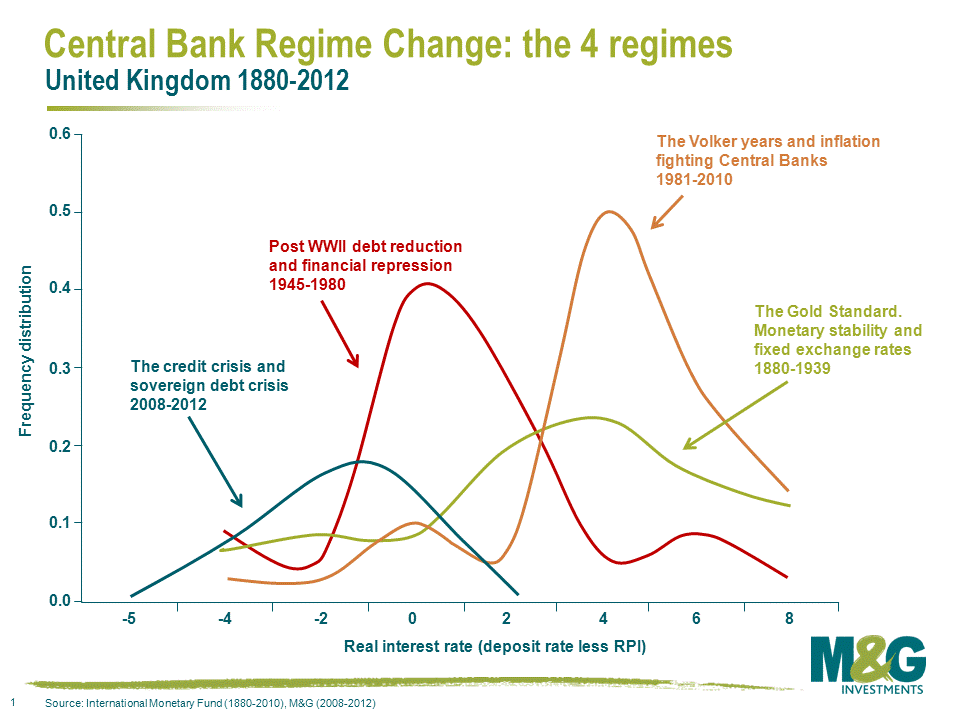Central Bank Regime Change: who cares about 2% inflation targets anymore? A chart.
For those clients who received our Panoramic fixed interest newsletter in December (the latest edition is out now by the way, with a detailed analysis of the global high yield market), you will have seen that I talked about Central Bank Regime Change as one of the key issues for fixed interest investors in the coming years. What I meant by Central Bank Regime Change is this: the days of Central Banks caring too much about inflation are behind us. We’ve had three decades since Paul Volker took over at the Fed and set interest rates above the rate of inflation (a novelty at the time), and we’ve had independence granted to the Bank of England, and seen inflation targets of 2% become commonplace. From here on in though, Central Banks will care about two things – unemployment and debt.
Charles Evans of the Chicago Fed is the only person who will publicly say it (admitting you don’t care about inflation anymore isn’t such good news for your government bond markets), but getting the unemployment rate down aggressively must be the priority for the authorities, otherwise we are doomed to structurally low growth and social unrest. If this means inflation overshoots that 2% level, he is relatively relaxed about that (3% would be very acceptable). And an inflation overshoot helps the developed world’s other big problem – debt. There are three ways to shrink an excessive debt burden. You can grow your way out of it (but with broken banks, austerity and high unemployment, below trend rather than above trend growth looks more likely – look at Greece). You can default on state liabilities to your populations (this is happening) or to your bondholders (less likely for regimes with their own currencies). Or you can set negative real interest rates and erode the debt burden through stealth inflation.
And this is the regime under which we are operating. The IMF put together part of the chart below – I’ve added the most recent period post the Great Financial Crisis. You can see that before the Second World War there was a wide range of real interest rates in the UK, with little pattern. For much of the period the UK was on the Gold Standard with fixed exchange rates. The period also includes the Great Depression where we experienced deflation. After the Second World War the UK emerged with a Debt/GDP ratio of over 200%. You can see that most of the next three decades was spent in low real rate environments, with periods of negative real rates. With financial repression making UK banks hold gilts, and some modest growth, the debt burden was aggressively eroded. The Volker years show a step change in real interest rates to sharply positive rates.
The final normal distribution curve shows the world we live in now. Since 2008 real rates have been sharply negative (justifying the unusual negative real yields on virtually all inflation linked bonds). Remember that no person in authority will ever be able to admit to regime change, but all of us have to understand it’s happening. What it might not automatically mean though is that we are in a big bond bear market. First we have to identify a regime (negative real rates), then understand whether the market is pricing that regime correctly (no, yields are too low) – but then you have to apply any structural overlays which might override your thoughts on fundamental valuation. And it’s here that Quantitative Easing becomes important. As Charlie Bean of the Bank of England’s MPC has stated, QE reduces “the cost of financing a given deficit”. Here in the UK, the Eurozone and the US, Central Banks are keeping bond yields low enough to stop their governments from going bust – and that’s not going to change for the foreseeable future.
The value of investments will fluctuate, which will cause prices to fall as well as rise and you may not get back the original amount you invested. Past performance is not a guide to future performance.


18 years of comment
Discover historical blogs from our extensive archive with our Blast from the past feature. View the most popular blogs posted this month - 5, 10 or 15 years ago!


Bond Vigilantes
Get Bond Vigilantes updates straight to your inbox






